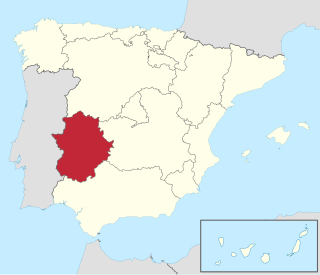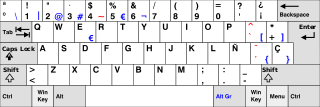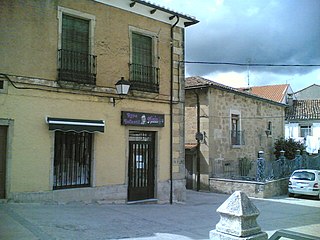
Portuguese is a Western Romance language of the Indo-European language family, originating in the Iberian Peninsula of Europe. It is the official language of Portugal, Brazil, Cape Verde, Angola, Mozambique, Guinea-Bissau and São Tomé and Príncipe, while having co-official language status in East Timor, Equatorial Guinea, and Macau. Portuguese-speaking people or nations are "Lusophones". As the result of expansion during colonial times, a cultural presence of Portuguese speakers is also found around the world. Portuguese is part of the Ibero-Romance group that evolved from several dialects of Vulgar Latin in the medieval Kingdom of Galicia and the County of Portugal, and has kept some Celtic phonology.

Extremadura is a landlocked autonomous community of Spain. Its capital city is Mérida, and its largest city is Badajoz. Located in the central-western part of the Iberian Peninsula, it is crossed from east to west by the Tagus and Guadiana rivers. The autonomous community is formed by the two largest provinces of Spain: Cáceres and Badajoz. Extremadura is bordered by Portugal to the west and by the autonomous communities of Castile and León (north), Castilla–La Mancha (east), and Andalusia (south).

Asturleonese is a Romance language spoken primarily in northwestern Spain, namely in the historical regions and Spain's modern-day autonomous communities of Asturias, northwestern Castile and León and Cantabria, and also in a small neighbouring area of Portugal. The name of the language is largely uncommon among its native speakers, as it forms a dialect continuum of mutually intelligible varieties and therefore it is primarily referred to by various regional glossonyms like Leonese, Cantabrian, Asturian or Mirandese. Extremaduran is sometimes included as well. Asturleonese has been classified by UNESCO as an endangered language, as Asturian is being increasingly replaced by Spanish.

Galician–Portuguese, also known as Old Galician–Portuguese, Old Galician or Old Portuguese, Medieval Galician or Medieval Portuguese when referring to the history of each modern language, was a West Iberian Romance language spoken in the Middle Ages, in the northwest area of the Iberian Peninsula. Alternatively, it can be considered a historical period of the Galician, Fala, and Portuguese languages.

Extremaduran is a group of vernacular Romance dialects, related to the Asturleonese language, spoken in Extremadura and adjoining areas in the province of Salamanca. It is difficult to establish the exact boundary between Extremaduran and the Spanish varieties spoken in most of Extremadura.

West Iberian is a branch of the Ibero-Romance languages that includes the Castilian languages, Astur-Leonese, and the descendants of Galician-Portuguese. Pyrenean–Mozarabic may also be included.

Leonese is a set of vernacular Romance language varieties currently spoken in northern and western portions of the historical region of León in Spain and a few adjoining areas in Portugal. In this narrow sense, Leonese is distinct from the dialects grouped under the Asturian language. There is no real linguistic division, though; it is only a purely political and identitary division, as dialectal areas are in fact shaped along a north-south axis. In the past, it was spoken in a wider area, including most of the historical region. The current number of Leonese speakers is estimated at 20,000 to 50,000. The westernmost fringes of the provinces of León and Zamora are in the territory of the Galician language, although there is dialectal continuity between the linguistic areas.

The majority of languages of Spain belong to the Romance language family, of which Spanish is the only language which has official status for the whole country. Those also include Catalan and Galician as well as an additional number of languages and dialects belonging to the Romance language continuum.
There have been many languages spoken in the Iberian Peninsula.
Castúo is the generic name for the dialects of Spanish spoken in the autonomous community of Extremadura, in Spain. Not to be confused with Extremaduran, a language between Asturleonese and Castilian, or Fala, another language spoken in Extremadura which is most similar to Galician-Portuguese.

Galician–Asturian or Eonavian is a set of Romance dialects or falas whose linguistic dominion extends into the zone of Asturias between the Eo River and Navia River. The dialects have been variously classified as the northeastern varieties of Galician, as a linguistic group of its own, or as a dialect of transition between Galician and Asturian, an opinion upheld by José Luis García Arias, the former president of the Academy of the Asturian Language (ALLA).

La Alamedilla is a town and municipality in Spain, in the province of Salamanca, part of the autonomous community of Castile-Leon. It has a population of 209 inhabitants.

San Martín de Trevejo is a municipality (municipio) located in the province of Cáceres, Extremadura, Spain. According to the 2008 census (INE), the municipality has 926 inhabitants.

Valverde del Fresno is a municipality located in the province of Cáceres, Extremadura, Spain. According to the 2006 census (INE), the municipality has a population of 2576 inhabitants.
Bercian is the generic name of the linguistic varieties spoken in El Bierzo region, in the province of León, Spain. They belong to the dialect continuum of Romance languages in northern Spain, linking the Galician and Leonese languages. Many of these varieties are on the brink of disappearing.

Extremadurans are the native people of Extremadura, in the central-west of Spain.

Galician, also known as Galego, is a Western Ibero-Romance language. Around 2.4 million people have at least some degree of competence in the language, mainly in Galicia, an autonomous community located in northwestern Spain, where it has official status along with Spanish. The language is also spoken in some border zones of the neighbouring Spanish regions of Asturias and Castile and León, as well as by Galician migrant communities in the rest of Spain, in Latin America including Puerto Rico, the United States, Switzerland and elsewhere in Europe.

Sierra de Gata is a comarca at the northern end of province of Cáceres in Extremadura, one of Spain's seventeen Autonomous Communities. The mountain range of Sierra de Gata is in the area and has given its name to the comarca. The main town is Moraleja.

The Jálama is a 1,487-metre (4,879 ft) mountain in western Spain.
There is a variety of Vernacular languages spoken in Spain. Spanish, the official language in the entire country, is the predominant native language in almost all of the autonomous communities in Spain. Six of the seventeen autonomous communities in Spain have other co-official languages in addition to Spanish. Bilingualism in different degrees and in distinct communicative situations between Spanish and another language is a habitual practice for many of the Spanish people who reside in one of these autonomous communities.

















